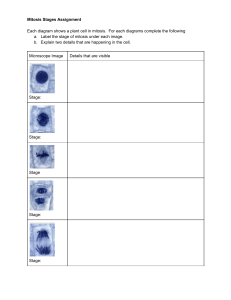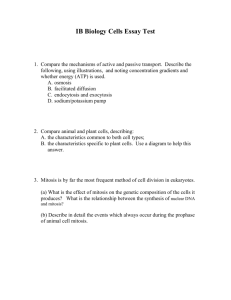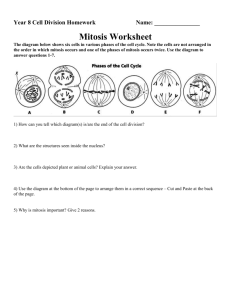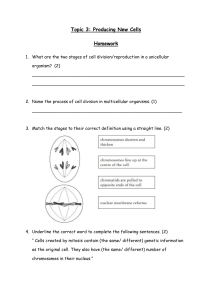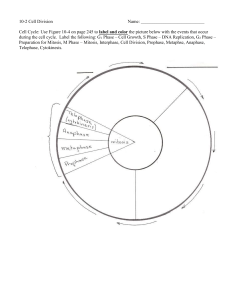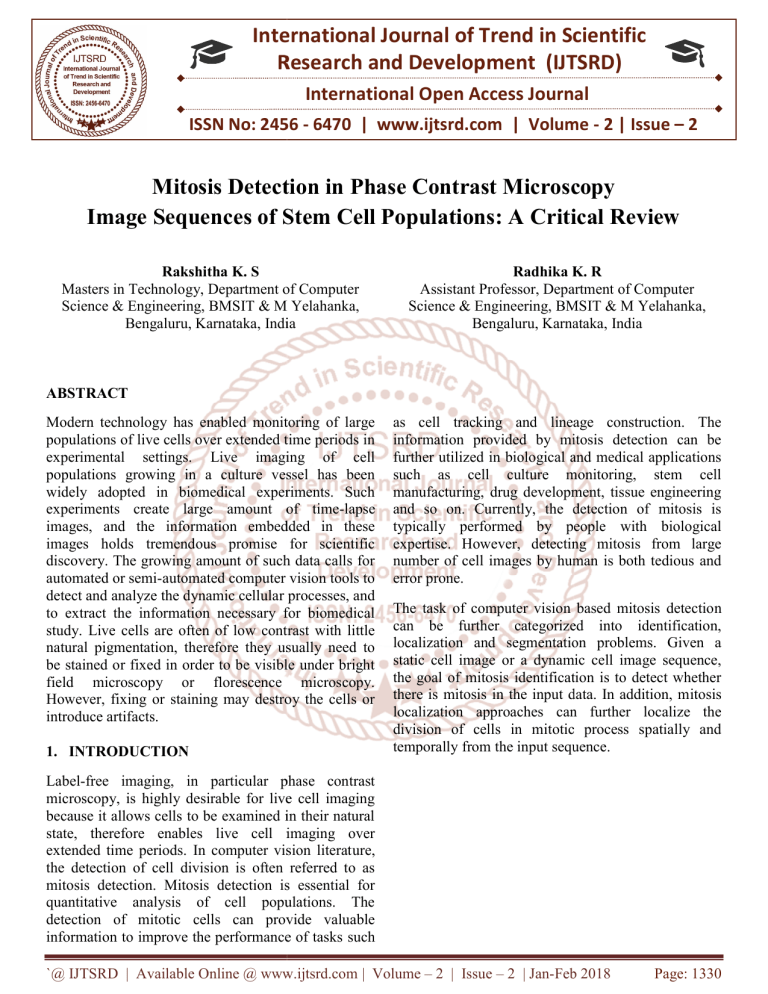
International Journal of Trend in Scientific
Research and Development (IJTSRD)
International Open Access Journal
ISSN No: 2456 - 6470 | www.ijtsrd.com | Volume - 2 | Issue – 2
Mitosis Detecti
Detection
on in Phase Contrast Microscopy
Image Sequences of Stem Cell Populations: A Critical Review
Rakshitha K. S
Masters in Technology, Department of Computer
Science & Engineering, BMSIT & M Yelahanka,
Bengaluru, Karnataka, India
Radhika K. R
Assistant Professor, Department of Computer
Science
nce & Engineering, BMSIT & M Yelahanka,
Bengaluru, Karnataka, India
ABSTRACT
Modern technology has enabled monitoring of large
populations of live cells over extended time periods in
experimental settings. Live imaging of cell
populations growing in a culture vessel has been
widely adopted in biomedical experiments. Such
experiments create large amount
ount of time
time-lapse
images, and the information embedded in these
images holds tremendous promise for scientific
discovery. The growing amount of such data calls for
automated or semi-automated
automated computer vision tools to
detect and analyze the dynamic cellularr processes, and
to extract the information necessary for biomedical
study. Live cells are often of low contrast with little
natural pigmentation, therefore they usually need to
be stained or fixed in order to be visible under bright
field microscopy or florescence
orescence microscopy.
However, fixing or staining may destroy the cells or
introduce artifacts.
1. INTRODUCTION
as cell tracking and lineage construction. The
information provided by mitosis detection can be
further utilized in biological and medical applications
such as cell culture monitoring, stem cell
manufacturing, drug development, tissue engineering
and so on. Currently, the detection of mitosis is
typically performed by people with biological
expertise. However, detecting mitosis from large
number of cell images by human is both tedious and
error prone.
The task of computer vision based mitosis detection
detectio
can be further categorized into identification,
localization and segmentation problems. Given a
static cell image or a dynamic cell image sequence,
the goal of mitosis identification is to detect whether
there is mitosis in the input data. In addition, mitosis
m
localization approaches can further localize the
division of cells in mitotic process spatially and
temporally from the input sequence.
Label-free
free imaging, in particular phase contrast
microscopy, is highly desirable for live cell imaging
because it allows cells to be examined in their natural
state, therefore enables live cell imaging over
extended time periods. In computer vision literat
literature,
the detection of cell division is often referred to as
mitosis detection. Mitosis detection is essential for
quantitative analysis of cell populations. The
detection of mitotic cells can provide valuable
information to improve the performance of tasks such
`@
@ IJTSRD | Available Online @ www.ijtsrd.com | Volume – 2 | Issue – 2 | Jan-Feb
Feb 2018
Page: 1330
International Journal of Trend in Scientific Research and Development (IJTSRD) ISSN: 2456-6470
Figure 1.Four stages of visual appearance transition
Based on the changes of visual appearance of stem
cells in phase contrast microscopy images, mitosis of
stem cells can be segmented into four stages, and each
of them is related to biological phases in the cell
circle: 1. Interphase stage, when the cells still looks
normal in appearance; 2. Start of mitosis, when the
cells begin to shrink, round up and get brighter while
going through prophase, metaphase and anaphase; 3.
Formation of daughter cells, when two daughter cells
become visible and attached with each other forming
the shape ‘8’ at the period of telophase; 4. Separation
of daughter cells, when two daughter cells get
completely sepa-rated after cytokinesis is completed.
These four stages in the visual appearance transition
are illustrated in fig1.
2. BACKGROUND AND RELATED WORK:
State-of-the-art methods for mitotic event detection in
microscopy image sequences can be generally
classified into the three following categories.
Method
3D-CNN [11]
Schuldt [12]
Niebles [14]
Dollar [15]
Jhuang [16]
Precision(%)
70.84
74.98
66.33
60.84
50.04
Recall(%)
66.39
71.36
61.04
62.79
49.74
Fig 2: Frame work of our approach
The number of mitotic figures visible in histology
sections is an important indicator for cancer screening
and assessment. Normally, the count is performed
manually by histologists, but automating the process
could reduce its time and costs (thus making it more
accessible), minimize errors, and improve the
`@ IJTSRD | Available Online @ www.ijtsrd.com | Volume – 2 | Issue – 2 | Jan-Feb 2018
Page: 1331
International Journal of Trend in Scientific Research and Development (IJTSRD) ISSN: 2456-6470
comparability of results obtained in different labs.
Mitosis detection is very hard. In fact, mitosis is a
complex process during which a cell nucleus
undergoes various transformations. In addition,
different image areas are characterized by different
tissue types, which exhibit highly variable
appearance. A large amount of different structures can
be observed in histology images stained with
Hematosin & Eosin, and in particular many dark-blue
spots, most of which correspond to cell nuclei.
As an additional complication, in later stages of the
mitosis process a nucleus may appear to split in two
dark-blue spots, to be counted as one single mitosis.
Our approach is conceptually very simple. We use a
supervised Deep Neural Network (DNN) as a
powerful pixel classifier. The DNN is a max-pooling
(MP) convolutional neural network (CNN). It directly
operates on raw RGB data sampled from a square
patch of the source image, centered on the pixel itself.
The DNN is trained to differentiate patches with a
mitotic nucleus close to the center from all other
windows.
3. CHALLENGES:
Unlike fluorescence imaging, phase contrast
microscopy is a form of nondestructive imaging
method. Under phase con-trast microscope, cells can
be monitored alive and continu-ously without
changing their structures. Therefore, automated
systems can be employed to observe and analyze cell
behaviors by recording time-lapse images [1].
Fig 3 (a-c) The dynamic process of mitosis in phase contrast images.
(d) shows a non-mitotic sequences
operates on raw pixel values, no human input is
Different from other pattern recognition tasks, most
mitotic cells have irregular shapes and appearance, as needed : on the contrary, the DNN automatically
shown in Figs. 3a, 3b, and 3c. Samples may vary in learns a set of visual features from the training data.
orientations (Figs. 3a and 3b), in appearances (Fig. 3b Our main contribution is a new, important, practical
in C3H10 dataset and Fig. 3c in C2C12 dataset), and application of DNN, which recently produced
in temporal lengths (Figs. 3a, 3b, and 3c).
outstanding results in image classification,
Moreover, some non-mitotic sequences may have segmentation and detection. Our approach is tested on
similar appearance as mitosis sequences (Fig. 3d), a publicly available dataset.Our detector is a DNNwhich might cause false positives in detection. based pixel classifier. Windows of class mitosis
Therefore it is not sufficient to simply search for the contain a visible mitosis around the window’s center.
shape ‘8’ through phase contrast images to detect Others contain off-center or no mitosis.
mitosis. Dense cell population data make mitosis
detection challenging, and the level of difficulty only Deep Neural Netwok architecture A DNN [4] is a
increases as live cells proliferate and further increase feed-forward net made of successive pairs of
the population density where neighboring cells convolutional and max-pooling layers, followed by
introduce ambiguity. Given their large number in a several fully connected layers. Raw pixel intensities
single microscopy image, it is difficult to find all of of the input image are passed through this general,
them by simply searching for a standard pattern. In hierarchical feature extractor. The feature vector it
recent years, many approaches have been proposed to produces is classified by the fully connected layers.
All weights are optimized through minimization of
solve this problem under different applications.
the misclassification error over the training set. Each
convolutional layer performs a 2D convolution of its
4. EXISTING SYSTEM:
input maps with a rectangular filter.
Mitosis in unseen images are detected by applying the
classifier on a sliding window, and post processing its
outputs with simple techniques. Because the DNN
`@ IJTSRD | Available Online @ www.ijtsrd.com | Volume – 2 | Issue – 2 | Jan-Feb 2018
Page: 1332
International Journal of Trend in Scientific Research and Development (IJTSRD) ISSN: 2456-6470
CONCLUSION:
In this paper we used four methods. Among all the
four methods deep learning method is the best
solution for detecting mitosis in phase contrast
microscopy. Compared with hand crafted features,
deep learning method could learn more discriminative
and data relevant features directly from image data.
REFERENCES
1. F. Yang, M. A. Mackey, F. Ianzini, G. Gallardo,
and M. Sonka, “Cell segmentation, tracking, and
mitosis detection using tempo-ral context,” in
Proc. Int. Conf. Med. ImageComput. Comput.Assisted Intervention., 2005, pp. 302–309.
2. O. Debeir, P. Van Ham, R. Kiss, and C.
Decaestecker, “Tracking of migrating cells phasecontrast video microscopy with com-bined meanshift processes,” IEEE Trans. Med. Imag., vol. 24,
no. 6,697–711, Jun. 2005.
3. K. Thirusittampalam, M. J. Hossain, O. Ghita, and
P. F. Whelan, “A novel frameworkfor cellular
tracking and mitosis detection in dense phase
contrast microscopy images,”IEEE J. Biomed.
Health Inform., vol. 17, no. 3, pp. 642–653, May.
2013.
4. A. Liu, T. Hao, Z. Gao, Y. Su, and Z. Yang,
“Nonnegative mixed-norm convex optimization
for mitotic cell detection in phase con-trast
microscopy,” Comput. Math. Methods Med., vol.
2013, Article ID 176272, p. 10, 2013, doi:
10.1155/2013/176272.
5. M. Marcuzzo, T. Guichard, P. Quelhas, A. M.
Mendonc¸a, and A. Campilho, “Cell division
detection on the arabidopsis thaliana root,” in
Proc. Iberian Conf. Pattern Recognition Image
Anal., 2009,168–175.
6. G. M. Gallardo, F. Yang, F. Ianzini, M. Mackey,
and M. Sonka, “Mitotic cell recognition with
hidden markov models,” in Med. Imag., vol. 5367,
pp. 661–668, 2004.
7. L. M. Vincent and P. Soille, “Watersheds in
digital spaces: An effi-cient algorithm based on
immersion simulations,” IEEE Trans. Pattern
Anal. Mach. Intell., vol. 13, no. 6, pp. 583–598,
Jun. 1991.
8. L. Liang, X. Zhou, F. Li, S. T. Wong, J. Huckins,
and R. W. King, “Mitosis cell identification with
conditional random fields,” in Proc. Life Sci. Syst.
Appl. Workshop, 2007, pp. 9–12.
9. D. C. Ciresan,¸ A. Giusti, L. M. Gambardella, and
J. Schmidhuber, “Mitosis detection in breast
cancer histology images with deep neural
networks,” in Proc. Int. Conf. Med. Image
Comput. Comput.-Assisted Intervention, 2013, pp.
411–418. Y.
10. Mao and Z. Yin, “A hierarchical convolutional
neural network for mitosis detection in phasecontrast microscopy images,” inProc. Int. Conf.
Med.
Image
Comput.
Comput.-Assisted
Intervention, 2016, pp. 685–692.
11. S. Huh, R. Bise, M. Chen, T. Kanade, D. F. E.
Ker, “Automated mitosis detection of stem cell
populations
in phase-contrast
microscopy
images,” IEEE Trans. Med. Imag., vol. 30, no.
3,586–596, Mar. 2011.
12. W. Nie, W. Li, A. Liu, T. Hao, and Y. Su, “3D
convolutional networks-based mitotic event
detection in time-lapse phase con-trast microscopy
image sequences of stem cell populations,”
inProc. IEEE Conf. Comput. Vis. Pattern
Recognition Workshops, 2016,55–62.
13. L. P. Morency, A. Quattoni, and T. Darrell,
“Latent-dynamic dis-criminative models for
continuous gesture recognition,” in Proc. IEEE
Conf. Comput. Vis. Pattern Recognition, 2007, pp.
1–8.
14. P. Felzenszwalb, D. McAllester, and D. Ramanan,
“A
discrimina-tively
trained,
multiscale,
deformable part model,” in Proc. IEEE Conf.
Comput. Vis. Pattern Recognition, 2008, pp. 1–8.
15. O. Al-Kofahi, R. Radke, S. Goderie, Q. Shen, S.
Temple, and B. Roysam. Automated cell lineage
construction: A rapid method to analyze clonal
development established with murine neural progenitor cells. Cell Cycle, 5(3):327–335, 2006.
16. O. Debeir, P. V. Ham, R. Kiss, and C.
Decaestecker. Tracking of mi-grating cells under
phase-contrast video microscopy with combined
mean-shift processes. IEEE Trans. Med. Imaging,
24(6):697–711, 2005.
17. O. Debeir, V. Megalizzi, N. Warzee, R. Kiss, and
C. Decaestecker. Videomicroscopic extraction of
specific information on cell prolif-eration and
migration in virto. Exp. Cell Res., 314(16):2985–
2998, 2008.
`@ IJTSRD | Available Online @ www.ijtsrd.com | Volume – 2 | Issue – 2 | Jan-Feb 2018
Page: 1333
International Journal of Trend in Scientific Research and Development (IJTSRD) ISSN: 2456-6470
18. A. Gunawardana, M. Mahajan, A. Acero, and J.
Platt. Hidden con-ditional random fields for phone
classification. In Proc. Interspeech, pages 1117–
1120, 2005.
19. D. House, M. Walker, Z. Wu, J. Wong, and M.
Betke. Tracking of cell populations to understand
thier spatio-temporal behavior in response to
physical stimuli. In Proc. IEEE Conference on
Computer Vision and Pattern Recognition
Workshop on Mathematical Methods in
Biomedical Image Analysis, pages 186–193,
2009.
20. S. Huh, D. Ker, R. Bise, M. Chen, and T. Kanade.
Automated mi-tosis detection of stem cell
populations in phase-contrast microscopy images.
IEEE Trans. Med. Imaging, 30(3):586–596, 2011.
21. T. Joachims. Making large-Scale SVM Learning
Practical. Advances in Kernel Methods - Support
Vector Learning. MIT-Press, 1999.
22. S. Kumar and M. Herbert. Discriminative random
fields: A frame-work for contextual interaction in
classification. In Proc. Interna-tional Conference
on Computer Vision, pages 1150–1157, 2003.
23. Proc. International Conference on Machine
Learning, pages 282– 289, 2001. J. Pearl
Probabilistic Reasoning in Intelligent Systems:
Networks of Plausible Inference. Morgan
Kaufmann, 1988.
24. H. Quastler and F. Sherman. Cell population
kinetics in the intestinal epithelium of the mouse.
Exp. Cell Res., 17(3):420–438, 1959.
25. A. Quattoni, S. Wang, L. Morency, M. Collins,
and T. Darrell. Hid-den conditional random fields.
IEEE Trans. Pattern Anal. Mach. In-tell., 29(10)
`@ IJTSRD | Available Online @ www.ijtsrd.com | Volume – 2 | Issue – 2 | Jan-Feb 2018
Page: 1334

